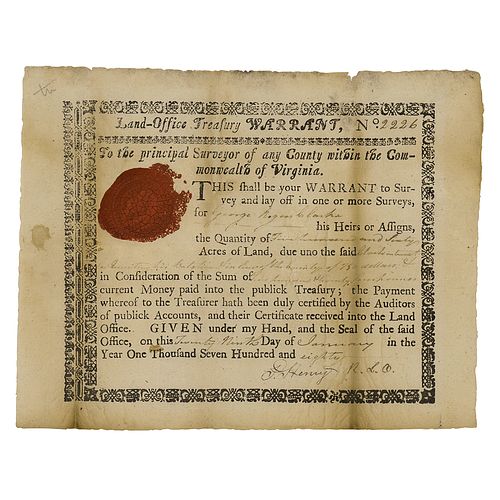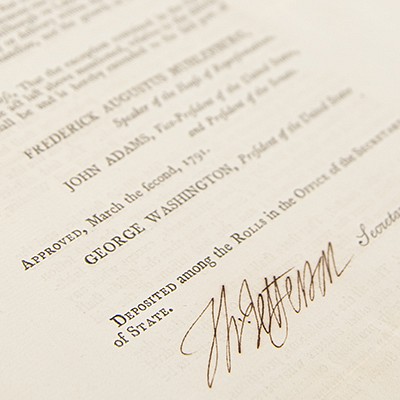Patrick Henry Document Signed
Two ways to bid:
- Leave a max absentee bid and the platform will bid on your behalf up to your maximum bid during the live auction.
- Bid live during the auction and your bids will be submitted real-time to the auctioneer.
Bid Increments
| Price | Bid Increment |
|---|---|
| $0 | $5 |
| $50 | $10 |
| $200 | $25 |
| $500 | $50 |
About Auction
Aug 10, 2022
RR Auction support@rrauction.com
- Lot Description
Revolutionary War-dated partly-printed DS, signed “P. Henry,” one page, 8.25 x 6.5, January 29, 1780. A Land-Office Treasury warrant, No. 2226, which reads: "This shall be your warrant to Survey and lay off in one or more Surveys for George Rogers Clark, his Heirs or Assigns, the Quantity of Five hundred and Sixty Acres of Land, due unto the said Clark interest for Recruiting his Batalion & in lieu of the County of 750 dollars & in Consideration of the Sum of Two hundred & twenty four pounds current Money paid into the publick Treasury." Signed at the conclusion by Patrick Henry. Retains the original red wax seal. In very good to fine condition, with toning along the vertical folds.
George Rogers Clark was an American surveyor, soldier, and militia officer from Virginia (1752-1818) who became the highest-ranking American patriot military officer on the northwestern frontier during the American Revolutionary War. He served as leader of the militia in Kentucky (then part of Virginia) throughout much of the war, and is best known for his captures of Kaskaskia (1778) and Vincennes (1779) during the Illinois Campaign, which greatly weakened British influence in the Northwest Territory. The British ceded the entire Northwest Territory to the United States in the 1783 Treaty of Paris, and Clark has often been hailed as the ‘Conqueror of the Old Northwest.’
That this document pertains to Clark’s compensation for “Recruiting his Batalion” is extremely fascinating. In December 1777, Clark presented to Virginia Governor Patrick Henry his plan to perform a long-distance strike against the British. Intent on seizing outposts north of the Ohio River and destroying British influence among their Indian allies, Clark asked Henry for permission to lead a secret expedition to capture the British-held villages at Kaskaskia, Cahokia, and Vincennes in the Illinois country. Governor Henry commissioned him as a lieutenant colonel in the Virginia militia and authorized him to raise troops for the expedition, with Clark and his officers taking on volunteers from Pennsylvania, Virginia, and North Carolina. Clark’s victories proved a resounding success—Kaskaskia and Cahokia were captured without firing a shot—with his taking of Vincennes on February 25, 1779, cementing his reputation as an early American military hero. Given that Clark's achievement had been gained without support from the regular army, either in men or funds, this document may in fact represent a portion of Clark’s well-deserved remuneration. - Shipping Info
-
Bidder is liable for shipping and handling and providing accurate information as to shipping or delivery locations and arranging for such. RR Auction is unable to combine purchases from other auctions or affiliates into one package for shipping purposes. Lots won will be shipped in a commercially reasonable time after payment in good funds for the merchandise and the shipping fees are received or credit extended, except when third-party shipment occurs. Bidder agrees that service and handling charges related to shipping items which are not pre-paid may be charged to a credit card on file with RR Auction. Successful international Bidders shall provide written shipping instructions, including specified Customs declarations, to RR Auction for any lots to be delivered outside of the United States. NOTE: Declaration value shall be the item’(s) hammer price and RR Auction shall use the correct harmonized code for the lot. Domestic Bidders on lots designated for third-party shipment must designate the common carrier, accept risk of loss, and prepay shipping costs.
-
- Buyer's Premium



 EUR
EUR CAD
CAD AUD
AUD GBP
GBP MXN
MXN HKD
HKD CNY
CNY MYR
MYR SEK
SEK SGD
SGD CHF
CHF THB
THB











